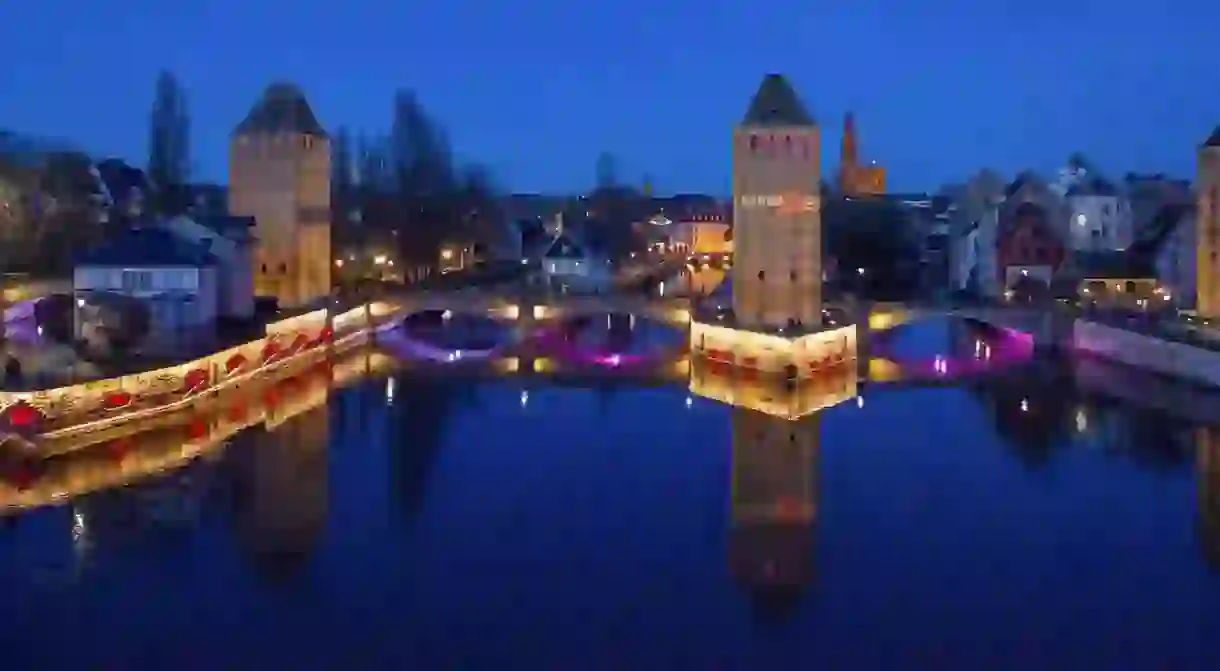Top Bridges in Strasbourg You Must See

You can read the bridges of Strasbourg like a history book. In 1988 Unesco gave World Heritage status to the Grande Île, the island enclosed by the Ill river and a loop of the Marne-Rhine canal in the oldest part of Strasbourg. Starting in Petite France and working your way north to the European Institutions is a great way to learn the history of Strasbourg, as each bridge reveals a layer in the development of the great city.
The Covered Bridges
Right on the very tip of the Grand Île beyond the Petite France area we come to the Covered Bridges. Despite losing their tiled roofs back in the 18th century, the name remains. They are overlooked by four towers dating from the 14th century, which are the remains of the former ramparts although immediately after the absorption of Strasbourg by France in 1681, a new ring of fortifications was built superseding these fortifications.
Pont du Corbeau
The charming narrow streets and half-timbered waterside homes belie a tumultuous and not always pretty past. In the Middle Ages, the Pont du Corbeau (raven bridge) was the place of public executions. It was known as the bridge of torture. Those condemned to death were locked in a cage and exposed on the bridge to passers-by for a few days before being tossed to their death in the dark waters below.

Pont de Saverne
If you take the tram from the train station you will probably be passing by the Saverne bridge. The first wooden bridge existed here already in the 12th century. With the catchy name of Bischofsburgethorbrücke, the first structure was a simple wooden footbridge. In 1835, the wooden pillars were replaced by stone and later reinforced in 1970. With the arrival of the tram in 2009, the bridge was destroyed and completely rebuilt.
Pont Royal or Gallia
Another bridge traversed by the tram, the Pont Royal is mostly known by the name of Gallia. When the first bridge was built in the 15th century, the site was actually outside of the city ramparts, and was protected by two towers. In 1670, it was replaced by a pedestrian drawbridge that would be raised to allow commercial boats to pass. In 1840, the bridge was destroyed and rebuilt as a six-arch stone bridge so it would be resistant to fire and be used by modern artillery. In spite of being the most solid bridge so far, it was destroyed during the siege of 1870 and it was left to the Germans to rebuild it and integrate it into the new district of Neustadt during the feverish Imperial expansion of the city that saw it grow threefold in scope. As opposed to crooked and narrow streets on the Grande Île, the ‘new town’ had broad boulevards and straight streets that were more modern — and easier to police.

Pont de la Dordogne
The name of the bridge, “Dordogne” was given in honor of the department of the Dordogne in Nouvelle-Aquitaine, which welcomed thousands of Alsatian refugees during the occupation in World War II. This bridge has the dubious record of being the most highly anticipated project in Strasbourg, by reason of the endless number of preliminary projects it went through before it ever came to fruition. From 1880, the date on which the construction of a bridge was decided, all the way to 1962, when the works really began, several generations of architects succeeded each other with project after project in all shapes and forms.
Europe Bridge
The bridge was inaugurated in 1960 and the name of Pont de l’Europe signified the return of the peace in Europe and in particular the Franco-German reconciliation. This followed a long succession of ill-fated bridges, the first one dating to 1388, that were successive victims to the violent conflicts between the two nations.
The Passerelle des Deux Rives
The newest bridge, dedicated to pedestrians and cyclists, was built in 2004 approximately one mile east of the city. The structure is called the Passerelle Mimram but is mostly known as the Passerelle des Deux Rives as it spans the two shores of the Rhine, linking France and Kehl in Germany. There is a huge park on both banks called the Jardin des Deux Rives. In 2009, heads of state shook hands on the bridge to mark Nato’s 60th anniversary.














